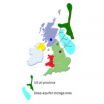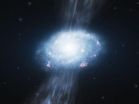(Press-News.org) Researchers at the University of British Columbia are deploying an underwater robot to survey ice-covered ocean in Antarctica from October 17 through November 12.
Scientists predict that the sea ice area around Antarctica will be reduced by more than 33 per cent by 2100, accelerating the collapse of ice shelves. Up to hundreds of metres thick, ice shelves are floating platforms of ice that cover almost half of Antarctica's coastline.
The mission will study the effect of ice shelves on the mixing of sea water, and will provide critical data for the Antarctica 2010 Glacier Tongues and Ocean Mixing Research Project led by investigator Craig Stevens at the New Zealand National Institute for Water and Atmospheric Research. The field site is located in New Zealand's Ross Dependency in Antarctica and the team includes scientists from New Zealand, Canada, the United States and France.
NB: Video footage and photographs of the underwater robot are available at:
http://supercritical.civil.ubc.ca/~efmweb/hamilton/Antarctica2010/
Until recently, scientists have had limited ability to access ice-covered waters, but the research team's use of a high-tech robot aims to change that.
"Few labs in the world are able to investigate the spatial variability of ocean properties under ice," explains Assoc. Prof. Bernard Laval, head of the UBC Autonomous Underwater Vehicle (AUV) and Fluid Mechanics research group.
"Findings from this study will be unique as there have only been a few under-ice AUV deployments globally, even fewer in the vicinity of ice shelves," says Laval, who teaches civil engineering in the Faculty of Applied Science.
The AUV, named UBC-Gavia, measures 2.5 metres long by half a metre wide and is equipped with temperature and salinity sensors, current meters, mapping sonar, a digital camera and water quality optical sensors. It will navigate the deep cold waters adjacent to, and possibly under, the floating 100-metre thick Erebus Glacier Tongue in McMurdo Sound, at a latitude of 77° south.
Traveling to Antarctica to operate the AUV are Andrew Hamilton and Alexander Forrest, UBC Civil Engineering PhD candidates in Laval's lab.
Hamilton and Forrest will pre-plan the AUV missions, setting the flight path and depth for the robot to follow and selecting what sensors to activate. These instructions are uploaded to the AUV, which then dives under the ice collecting data on its own, returning to the ice-hole at the end of the mission.
"The deployments are expected to return important data from a largely uncharted ocean environment," says Hamilton, who specializes in environmental fluid mechanics.
"Under‐ice datasets will allow us to better understand ice-ocean interactions and provide valuable information for climate modelers."
New Zealand's Stevens, who worked as a postdoctoral researcher at UBC in the early 1990s, says, "The key is to try and locate the mixing hotspots in time and space. These hotspots appear to be perhaps 1,000 times more energetic than background conditions. The AUV is a key component of our suite of instruments and provides the vital spatial element."
###
END
Legalizing marijuana in California will not dramatically reduce the drug revenues collected by Mexican drug trafficking organizations from sales to the United States, according to a new RAND Corporation study.
The only scenario where legalization in California could substantially reduce the revenue of the drug trafficking organizations is if high-potency, California-produced marijuana is smuggled to other U.S. states at prices that are lower than those of current Mexican supplies, according to the study from the RAND Drug Policy Research Center. RAND is a nonprofit research ...
Since the late 1990s, deep brain stimulation (DBS) has proven to be a lifeline for some patients suffering from Parkinson's disease, a cruel neurological disorder that can cause lack of control over movement, poor balance and coordination, and rigidity, among other symptoms.
The procedure is used only for patients whose symptoms cannot be adequately controlled with medications. A neurosurgeon uses magnetic resonance imaging or computed tomography to identify the exact target within the brain where abnormal electrical nerve signals generate the disease's tremors and ...
ST. PAUL, Minn. – New research suggests that walking at least six miles per week may protect brain size and in turn, preserve memory in old age, according to a study published in the October 13, 2010, online issue of Neurology®, the medical journal of the American Academy of Neurology.
"Brain size shrinks in late adulthood, which can cause memory problems. Our results should encourage well-designed trials of physical exercise in older adults as a promising approach for preventing dementia and Alzheimer's disease," said study author Kirk I. Erickson, PhD, with the University ...
PHILADELPHIA (October 13, 2010) – Creamy. Gritty. Crunchy. Slimy. Oral texture perception is a major factor contributing to each person's food preferences. Now, a new study from the Monell Center reports that individuals' perception of starch texture is shaped by variability in the activity of an oral enzyme known as salivary amylase.
"Differences in starch perception likely affect people's nutritional status by influencing their liking for and intake of starchy and starch-thickened foods," said study lead author Abigail Mandel, a nutritional scientist at Monell.
Starch, ...
New research found that the pattern of heart dysfunction with sarin exposure in mice resembles that seen in humans. Sarin is a chemical warfare agent belonging to class of compounds called organophosphates — the basis for insecticides, herbicides and nerve agents. As an inhibitor of the nervous system enzyme acetylcholinesterase, sarin can cause convulsions, stoppage of breathing and death.
Aiming to determine the delayed cardiac effects of sarin, researchers studied mice injected with sarin — at doses too low to produce visible symptoms — 10 weeks after the exposure. ...
It's not easy to wrangle fifth graders from noisy school hallways to get their blood pressure checked. But with an age-adjusted death rate due to heart disease substantially above the national average, West Virginia has a good reason to try.
In CARDIAC (Coronary Artery Risk Detection In Appalachian Communities), researchers collected blood pressure data on more than 62,000 West Virginia fifth graders and found that 12,245, or 19.7 percent, fall into the 95th percentile or above for blood pressure readings, based on norms for height and gender. Those children are considered ...
Curveballs curve and fastballs go really fast, but new research suggests that no pitcher can make a curveball "break" or a fastball "rise."
Led by Arthur Shapiro of American University and Zhong-Lin Lu of the University of Southern California, the researchers explain the illusion of the curveball's break in a publicly available study in the journal PLoS ONE (study available by request or post-embargo at http://dx.plos.org/10.1371/journal.pone.0013296).
The study comes a year after the same group won the prize for best illusion at the Vision Sciences annual meeting with ...
Oil recovery using carbon dioxide could lead to a North Sea oil bonanza worth £150 billion ($ 240 billion) – but only if the current infrastructure is enhanced now, according to a new study published today by a world-leading energy expert.
A new calculation by Durham University of the net worth of the UK oil field shows that using carbon dioxide (CO2) to enhance the recovery from our existing North Sea oil fields could yield an extra three billion barrels of oil over the next 20 years. Three billion barrels of oil could power, heat and transport the UK for two years ...
Last January astronomers thought they had witnessed a fresh collision between two asteroids when images from the NASA/ESA Hubble Space Telescope revealed a bizarre X-shaped object at the head of a comet-like trail of material.
"When I saw the Hubble image I knew it was something special," says astronomer Jessica Agarwal, who works for the European Space Agency in the Netherlands. "The nucleus seemed almost detached from the dust cloud and there were intricate structures within the dust."
After using Hubble to track the oddball body for five months, astronomers were ...
The first galaxies formed before the Universe was less than one billion years old and were much smaller than the giant systems — including the Milky Way — that we see today. So somehow the average galaxy size has increased as the Universe has evolved. Galaxies often collide and then merge to form larger systems and this process is certainly an important growth mechanism. However, an additional, gentler way has been proposed.
A European team of astronomers has used ESO's Very Large Telescope to test this very different idea — that young galaxies can also grow by sucking ...


